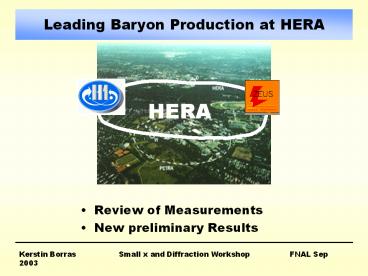Leading Baryon Production at HERA - PowerPoint PPT Presentation
Title:
Leading Baryon Production at HERA
Description:
agreement in shape and rate with One-Pion-Exchange MC models in both PHP and DIS ... En spectra, cross sections dependences on Q2, xp, x?,... LN: Dijet ... – PowerPoint PPT presentation
Number of Views:36
Avg rating:3.0/5.0
Title: Leading Baryon Production at HERA
1
Leading Baryon Production at HERA
HERA
- Review of Measurements
- New preliminary Results
Kerstin Borras Small x and
Diffraction Workshop FNAL Sep 2003
2
Motivation
- Significant fraction of ep scattering events
contain a leading baryon in the final state
carrying a substantial proportion of the energy
of the incoming proton - Production models not yet completely understood
- Vertex factorization can be tested
p,n
p,n
- Standard target fragmentation
- complex final-state with p or n in proton remnant
- or p stayed intact
Particle exchange p iso-scalar, iso-vector
(IR) n iso-vector (p)
3
Kinematics and Vertex Factorization
Photon vertex lepton variables Q2, x , W , y
- Proton vertex
- Leading baryon variables
- xL z xp or xn
- t (p p)2 - pT2 / xL
Cross section dependence on baryon
variables independent of particle production at
photon vertex
4
Leading Proton Production
Publication xL pT2 Structure Vertex Factor.
H1 semi-incl. DIS (LPLN,96/97) (Eur.Phys.J.C6,587(1999)) (X) X
H1 semi-incl. PHP DIS(96) (Nucl.Phys.B619,3(2001)) X X
ZEUS prel. ? in p-diss. PHP(97) (EPS 2001 652 ) X X
ZEUS semi-incl. DIS(94/95) (Nucl.Phys.B685,3(2002)) X X X X
ZEUS prel. semi-incl. DIS(96/97) (EPS 2003 544) X X
5
LP Cross Section as a function of XL
update with 96-97 data four times higher
statistic
- Data are very precise
- Flat for xLlt0.95
Non-diss. diffraction in xLgt0.97 ,
proton-diss. diffraction (ep?eXN) included in
xLlt0.97
6
LP Cross Section as a function of pT2
- High precision
- line exp(-6.7 pT2)
LPS acceptance in xL and pT2 (stations 4,5,6)
7
LP b-slopes as function of xL
- New data consistent with published 95 data
- Variation of b-slopes ? variation of pT2
acceptance - No dependence on xL visible
8
Leading Neutron Production
Publication XL pT2 Structure Vertex Factor.
H1 semi-incl. DIS (LPLN,96/97) (Eur.Phys.J.C6,587(1999)) (X) X (pion)
H1 prel. dijets in PHP DIS(96/97) (ICHEP 2002 988) X X (pion) X
ZEUS prel. semi-incl. DIS (99) (ICHEP 2000 882) X
ZEUS prel. ? in p-diss. PHP (97) (EPS 2001 652 ) X X
ZEUS dijets in PHP (95) (Nucl.Phys.B596,3(2001)) X X (pion) X
ZEUS semi-incl. PHPDIS (95-97) (Nucl.Phys.B637,3(2002)) X (X) X (pion) X
ZEUS prel. semi-incl. PHPDIS (00) (ICHEP 2002 824) X X
ZEUS prel. D in PHP (98-00) (EPS 2003 567) X X X
ZEUS prel. semi-incl. PHP(00) (EPS 2003 546) X(pion) X(pion)
9
LN xL spectrum for basic sample
Test the One-Pion-Exchange picture
Look at En spectra, cross sections
dependences on Q2, xp, x?,
xL gt 0.5 agreement in shape and rate with
One-Pion-Exchange MC models in both PHP and DIS
10
LN Dijet differential cross sections
PHP
DIS
One-Pion-Exchange simulation with different pion
structures describe data in shape and in
normalization No preference for any structure
function yet.
11
LN Pion trajectory
Pion flux
xL independent
Cross section for neutron production
12
LN Pion trajectory
(1-xL) distributions behave power law like in
different t ranges
powers aeff(t)
Powers aeff(t) are linear dependent on t
aeff(t)1.060.080.52-0.42 (2.780.330.30-0.42
GeV-2) t
One-Pion-Exchange (ap(t)t-mp2) aIP(0)
1.060.080.52-0.42 ap 1.380.170.15-021
GeV-2
13
LN Vertex Factorization
No dependence on particle production at upper
vertex compare ?p with pp
Factor of two different ! New developments with
recent measurements from NA49 (EPS 2003)
14
LN Vertex Factorization II
RHO production in PHP
Dijet production in PHP and DIS
? No significant violation
15
Summary
- A lot of precise leading baryon measurements at
high energies available now - Knowledge on xL spectra, pT2 distributions,
b-slopes, structures and vertex factorization
greatly increased - Phenomenological and theoretical input for
describing the data and comparisons to TeVatron
measurements needed - Tune available (new?) models to high energy
behavior - t-distribution in LP at HERA comparable to
TeVatron ? - Clarify Pion flux models
- Vertex factorization violation or holding
depending on final state ?
16
NA49 preliminary EPS 2003































